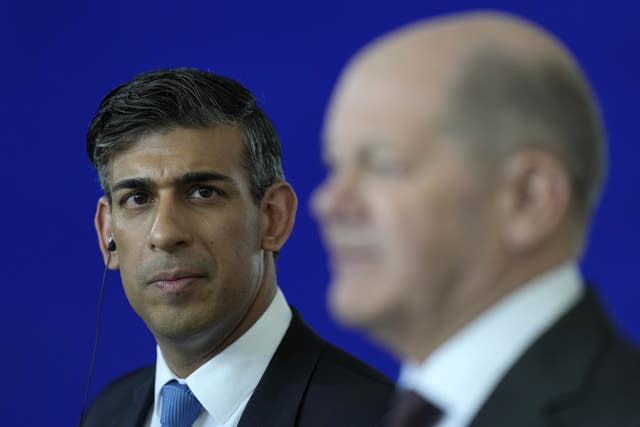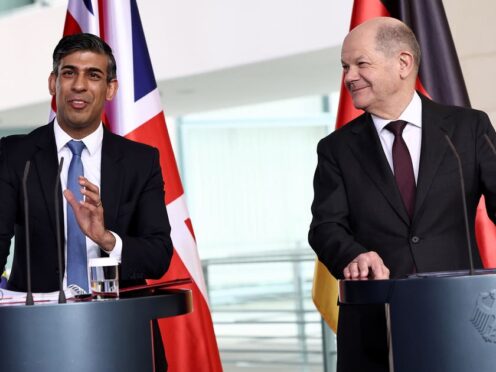Rishi Sunak said he has made a choice to “prioritise defence” as he declined to rule out cuts to other spending areas outside the NHS and schools, defending his pledge as “fully funded”.
The Prime Minister has committed to reaching 2.5% of gross domestic product (GDP) by 2030, spending more than £75 billion more on defence over the next six years compared with current levels.
The commitment will be funded by slashing 72,000 civil service jobs, but economists have warned it will also require deep cuts in other areas of public spending.
Asked at a press conference in Berlin whether his defence increase will mean tax rises and deep cuts, he said that was “not a fair characterisation”.
“The plan that I announced yesterday is fully funded. It’s funded rightly by a reduction in the civil service headcount back to 2019 levels… combined with an uplift in R&D spending.
“But you’re right. We are making a choice to prioritise defence. I think that’s the right thing because, whether we like it or not, the world is more dangerous than at any moment since the Cold War.”
Pressed to rule out further cuts, the Prime Minister said: “We have record investment in our public services, including the NHS – that’s not going to change, it’s going to continue.

“We have record investment in our schools – that’s not going to change, it’s going to continue to increase. And alongside that we are able to cut people’s taxes.”
Without mentioning spending in other areas outside health and education, he continued: “I am not going to get into writing the next manifesto here and now, but what I am confident about is that if you have a strong plan for the economy as we have, and that plan is working, we stick to that plan we will be able to continue increasing defence spending.
“It is a completely funded plan. We have got a very clear idea of how to reduce civil service headcount which has grown considerably over the last few years, and we can bring that back and use that to fund what I announced yesterday.
“Alongside that, continue to invest in public services and cut people’s taxes.”
The Prime Minister also said it was “entirely reasonable” for the US to call for more European defence spending.
At the joint presser with Mr Sunak, German Chancellor Olaf Scholz expressed confidence in Nato’s long-term future, when asked about the prospect of alliance-sceptic Donald Trump returning to the White House.
Mr Sunak will use a summit marking the 75th anniversary of Nato to lobby allies to match his defence spending commitment.
At the Washington DC summit in July, the Prime Minister and Defence Secretary Grant Shapps will argue that spending 2.5% of GDP should be the benchmark for members of the alliance.
The current Nato target for defence spending is 2% – although only 11 members of the alliance met that goal in 2023.
The UK Government wants that benchmark to increase to 2.5%, which would add £140 billion to the Nato budget if met by all 32 members.
“We’re now saying we think that should be 2.5%. We think in a more dangerous world that would make sense,” Mr Shapps told Times Radio.
He told Sky News: “I will be arguing that, and I know that the Prime Minister feels strongly about it, when we go to the Nato 75th anniversary summit which is in Washington DC.”
The 2% target was set 10 years ago “when we didn’t have the significant rise of China, North Korea now nuclear-armed, Iran attacking and using its proxies to attack, and a very much less stable world given Russia’s full scale invasion of Ukraine”, Mr Shapps said.
The Institute for Fiscal Studies (IFS) said unprotected areas of public spending will now face cuts of around 4% a year after 2025 to help meet the defence commitment.
“For decades, steady reductions in the amount spent on defence allowed for extra spending on things like the NHS without a need to increase taxes. In essence, we replaced a warfare state with a welfare state,” IFS economist Ben Zaranko said.
“The challenge now is that we’re going to have to pay for both.”
Downing Street said the plan would cost £4.5 billion in 2028/29, of which £2.9 billion would come from savings due to the reduction in the size of the civil service, with £1.6 billion coming from the research and development budget.
“There has been work under way with the Treasury and departments on that plan after announcing that we would cap headcount to pre-pandemic levels. What we’ve now done is come forward with the costings associated with that and confirmed that that will be reallocated to the defence budget,” a No 10 spokeswoman said.
For decades, steady reductions in the amount spent on defence allowed for extra spending on things like the NHS without a need to increase taxes. In essence, we replaced a warfare state with a welfare state.
The challenge now is that we're going to have to pay for both. pic.twitter.com/dku96KuxTg
— Ben Zaranko (@BenZaranko) April 23, 2024
But No 10 would not give any further details of where jobs would be lost or whether the reduction in headcount could be achieved through natural wastage or if it would require redundancies.
Details would be set out at a future spending review, the spokeswoman said.
Some of the reduction in civil service numbers could be offset through the use of technology including artificial intelligence, she said.
The Tories hope the Prime Minister’s commitment will be a key dividing line with Labour at the general election.
Labour has promised to conduct a strategic defence and security review in its first year in office to understand the resources required to meet the threats facing the UK, but has also committed to a 2.5% target when finances allow.
Mr Shapps said he was “very disappointed” by the Opposition’s response.
But shadow defence secretary John Healey said the Tories “have shown time and time again that they cannot be trusted”, and “since 2010, the Conservatives have wasted more than £15 billion mismanaging defence procurement, shrunk the army to its smallest size since Napoleon, missed their recruitment targets every year, and allowed morale to fall to record lows”.
